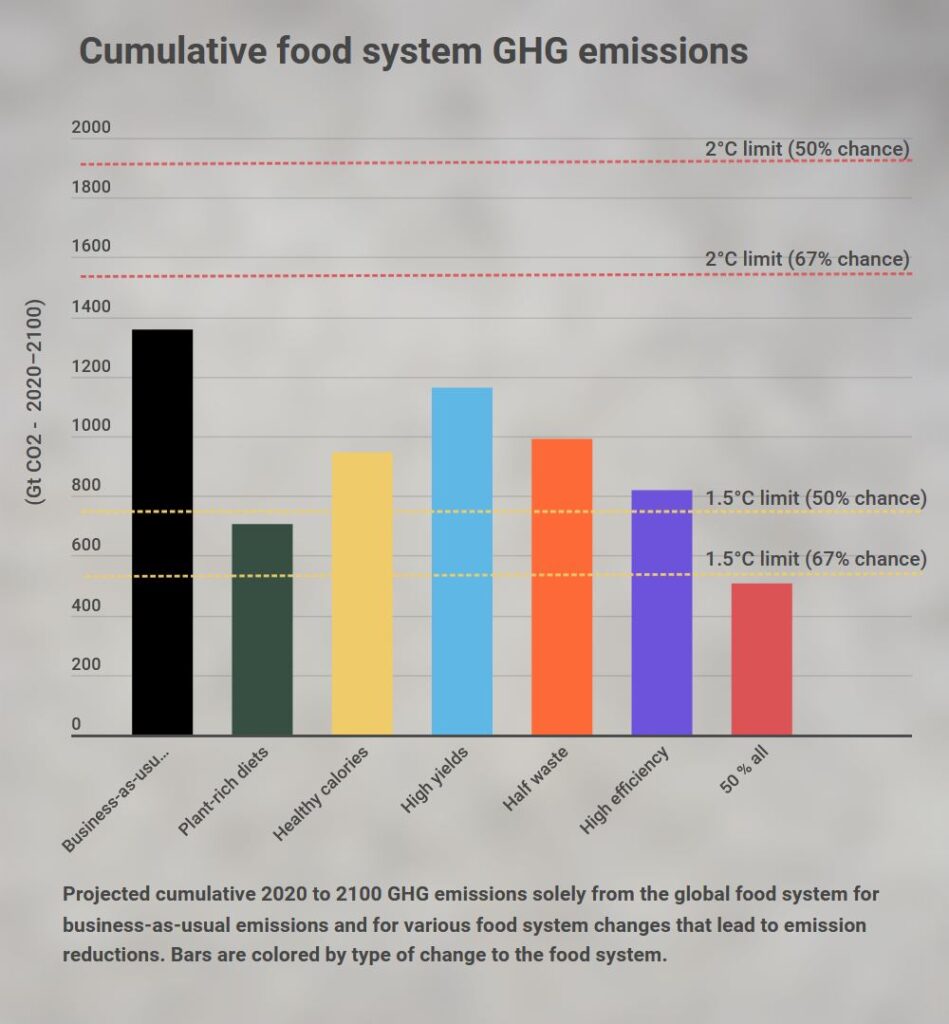On October 23, 2022, Mirjam Herrmann, a Member of the climate activist group “Letzte Generation” threw mashed potatoes on the Claude Monet painting “Les Meules” and asserted: “We are in a climate catastrophe… I’m afraid because science tells us that we won’t be able to feed our families in 2050.“ Though her concerns are valid, this claim turns out to be mostly false.
To fully understand where Herrmann’s concerns are coming from, we will need to look into different aspects that affect our food system and their impacts on the climate.
What is food security?
Food Security is granted when: all people, at all times, have physical, social, and economic access to sufficient, safe, and nutritious food.
Current climate state and food security
820 million people were suffering from hunger in the year 2021 as shown in the latest State of Food Security and Nutrition report. But instead of moving forward and fighting against these horrible numbers, the world is moving backward to wipe out hunger and malnutrition. In addition to these numbers, the global food demand continues to grow. The world population is expected to hit 9.6 Billion by the year 2050. To globally provide food security in the future, it is crucial to reduce the climate impacts on agricultural lands and livestock productivity.
Another crucial factor will be limiting the global temperatures, as pursued in the Paris Agreement, to a maximum of 1.5 °C. A team of scientists from different American universities last year calculated that it is nearly impossible to accomplish this without totally changing our food system, as shown in graphic 1.
In this graphic they are saying that even if fossil fuel emissions were immediately obliterated, the global food system’s emissions would make achieving the 1.5 C target nearly impossible as well as endanger the 2 °C targets by the end of the century. If the global warming level hits 2 °C, the food production system will be much more negatively impacted than ever before. In fact, due to high temperatures and heavy rainfalls, soil health and the nutritional quality of crops are already in great danger. Resulting in alarming projections like that climate change will put 8 to 80 million people at risk of hunger in mid-century.
So to sum up: The unsustainable methods currently used to produce food and feed the population are seriously harming our chances of food security in the future. But even though the situation isn’t promising and the climate state worsens, food security in 2050 will be provided. Although, the quality of food stands in question.
To better our chances of producing enough nutritional food in the future, limiting global warming by lowering fossil fuel emissions is crucial as well as reflecting our eating habits.
The issue with beef
Animal-based foods are much more resource-draining than plant-based foods. For example, beef is one of the most resource-draining foods to produce. It calls for 20 times more land and has much more CO2 emissions per kilogram than plant-based foods.
If the efficiency of beef production is kept up, pastureland is estimated to expand by 400 million hectares between 2010 and 2050. So if the demand for beef grows with the growing population, it will very likely increase the pressure on forests. The inevitable deforestation that would occur in that case could increase global emissions enough to make meeting the Paris Agreement impossible – leading to a possible climate crisis.
To feed the growing population sustainably in the future, the efficiency of conventional agriculture needs to be improved. Algae, Seaweed, Beans, Nuts, and even Insects will very likely become a big part of our diets in the future. Nevertheless, if we start farming more sustainably, conserve our resources as well as introduce more locally and seasonally appropriate plant-based diets, there are better chances of providing enough nutritional food for the growing population.
The food system and Global Warming
To better understand Mirjam Herrmann’s concerns, it is necessary to for example take a look at the latest Emissions Gap Report 2022. The report says that our food system is currently accountable for around a third of all GHG emissions worldwide (18 GtCO2e/year, range: 14–22 GtCO2e). The emissions that are produced come from multiple sources related to our food system, such as 39% from agricultural production (7.1 GtCO2e). 32% (5.7 GtCO2e) come from changes in land use, while 29% (5.2 GtCO2e) are because of supply chain activities.
Projections of the United nation’s environmental program show that food system emissions could reach around 30 GtCO2e/year by 2050 and that Herrmann’s concerns are justifiable.
Unit of measure “GigatonneCO2-Equivalent” (GtCO2e): This measure is often used in climate reports or in general when talking about the global human carbon dioxide emissions. A gigatonne is equivalent to 1.000.000.000 tonnes. Other greenhouse gases are converted to CO2 according to their impact on global warming.
Conclusion
The impact and influence of climate change are a big problem for our food security now – and will be in the year 2050. Nevertheless, looking at today’s predictions we will be able to feed our families in 2050. Therefore, Miriam Herrmann’s statement is mostly false. But if we continue to consume and produce foods like we do these days, the risk of not fulfilling the Paris Agreement as well as our chances of losing our food security will grow. As a matter of fact, the food system itself produces about one-third of all global emissions. This proves that we will have to adapt our eating habits like reducing our meat consumption, eating more regional, and adopting more plant-based products in our diet. We must put more effort into changing our agricultural and food sector. Because that will give us a realistic chance of achieving our climate goals, which will lead to better food security for our families in the future.
RESEARCH | ARTICLE: Tom Klose & Hümeyra Tukat, Hochschule der Medien, Stuttgart (Germany)
Leave our comments, thoughts and suggestions in the box below. Take note: your respons is moderated.

 1 year ago
85
1 year ago
85



